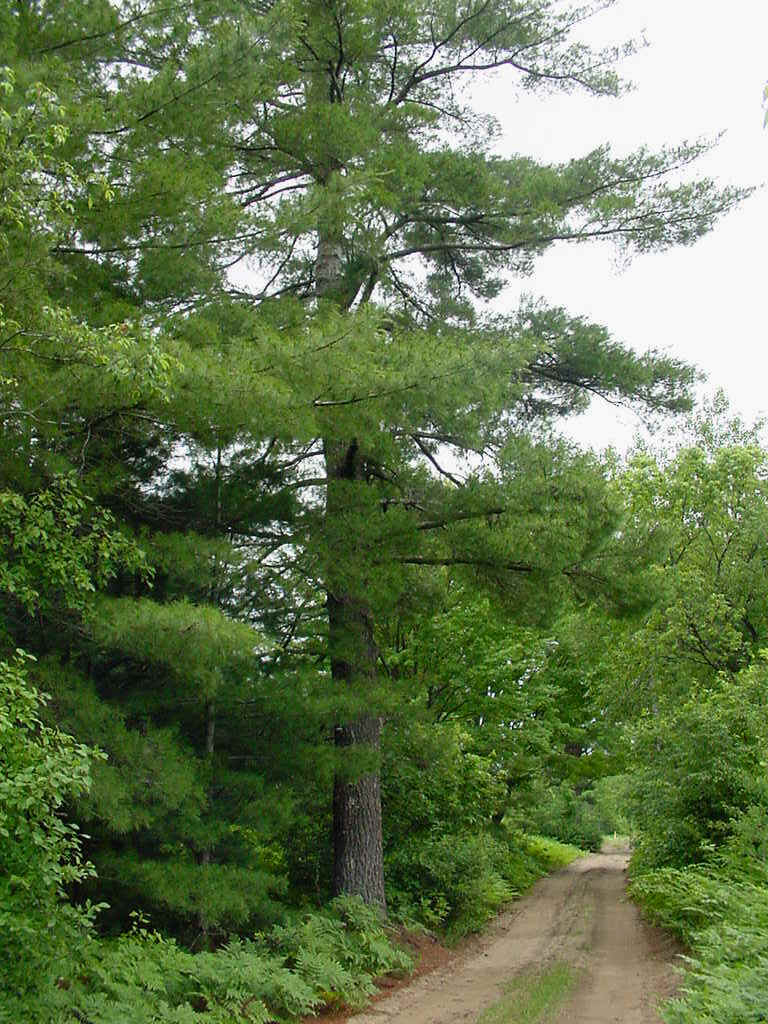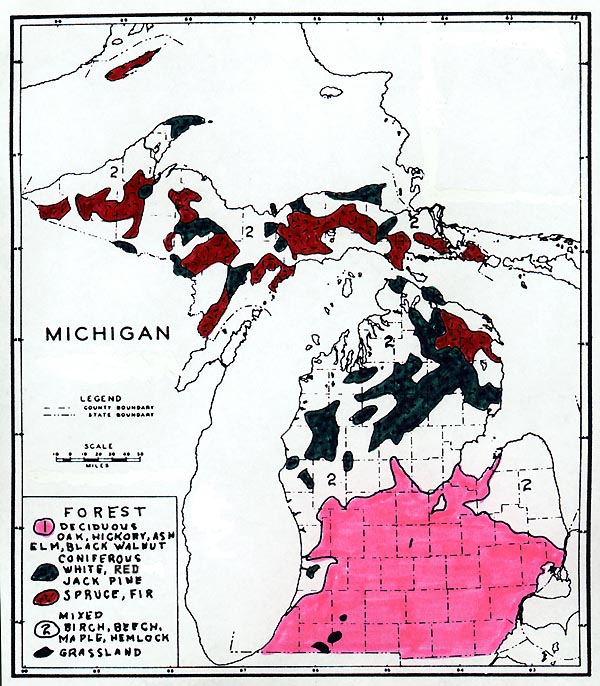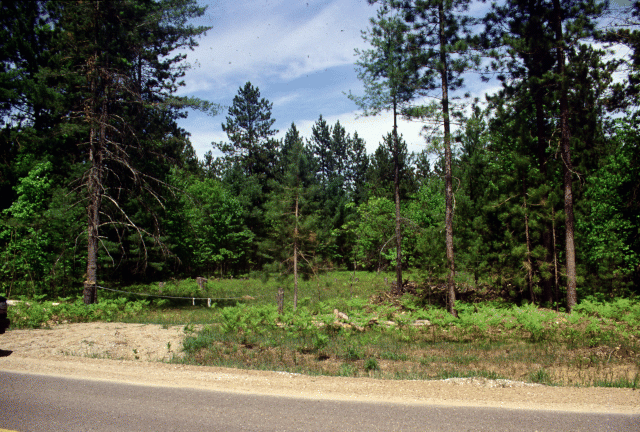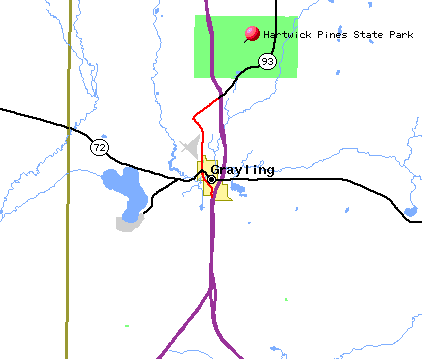White pine, the state tree of Michigan, is distinctive and easy to spot in a forest. The two images below show the typical branching pattern of the white pine (the large tree). .

Source: Photograph courtesy of Randy Schaetzl, Professor of Geography -
Michigan State University
The dark areas on the map below show where white and red pine forests were dominant in
Michigan, prior to European settlement. Note that most of them are north of the floristic tension zone.

Source: Unknown
Red pine does not get as large as white pine, and is found on slightly "drier",
yet still sandy, soils. Red pine has three needles per cluster, while white pine has
five needles in a cluster.

Source: Photograph courtesy of Randy Schaetzl, Professor of Geography - Michigan State University
One of Michigan's most popular state parks is Hartwick Pines State Park. This park is home to a large stand of virgin white pine trees, many of which are very large. Visit Hartwick Pines State Park, which is just north of Grayling, and you will be impressed!
Here's an excerpt from an article about the park:
With nearly 10,000 acres, we have the biggest state park in the lower peninsula and the
fifth largest park in the entire state. It's HARTWICK PINES STATE PARK, just North of
Grayling off I-75, open daily 8am to 10pm. The "Pines" is the location of the
Michigan Forest Visitors Center, the official state interpretive center of the Michigan
forest industry, from the rustic logging era of the late 1800's to the modern high-tech
forest product industries of today.

"Michigan's Forest...its Past, Present and Future," is the theme of the 1,500
square foot exhibit hall. Visitors find hands-on exhibits, dioramas and the talking
"Living Tree". Interpreted is the natural origin of the Michigan forest, the
lumber era, forest products of yesterday and today and the development of forest
management.
Within the Visitors Center is a 105-seat auditorium featuring a
nine-projector multi-image slide program. "The Forest, Michigan's Renewable
Resource." The 14-minute show orients visitors to the story of Forest Management from
the logging era to the present. The Auditorium also hosts a variety of programs, videos
and special presentations.
Groups will find space for meetings and education opportunities in the
conference style classroom. This room features a TV/VCR unit and a whiteboard. Seating
capacity is approximately 35. The room is available by reservation.
The Michigan Forest Visitor Center is open all year. School groups can
make a reservation for a guided experience by calling (517) 348-2537. For information
write : Michigan Forest Center, Hartwick Pines State Park, Route 3, Box 3840, Grayling,
Michigan 49738.
Established in the 1920's, the park was donated to the state by Karen
Hartwick in memory of her husband Edward E. Hartwick, a lumberman who was killed in World
War I.
The principal feature of the park is the forest of virgin white pines.
At one time totaling 85 acres, storm damage and age have reduced the mature forest to some
49 acres. Stretching skyward for 150 feet and more, the giant pines are the only remnants
of what Michigan looked like before the arrival of men with axes. The venerable Monarch
white pine, tallest in the park, stands 155 feet 45 inches tall and is over 300 years old.
By the 1860's the forests in the Eastern part of the country had been
depleted, and Michigan became a source of supply. By 1869 the state had became the largest
lumber producer in the country, and maintained that distinction until the turn of the
century.
Vast quantities of white pine went to re-build Chicago after the great
fire, and to build the towns and villages popping up along the railroads in the treeless
great plains.
Each year more than 250,000 visitors stroll through the pines,
marveling at trees here before the Revolutionary War. Foot trails wind through the virgin
forest area, with guided interpretive hikes, and evening programs available from
professional park interpreters. The park abounds in a multitude of ecosystems in addition
to mature and immature pine forests, including lakes,
streams, swamps and hardwood hills, which support thousands of bird, animal and plant
species.
A replica old time logging camp shows how thousands of men lived and
worked in the forests a century ago. During several weekends in the warm months the camp
comes alive when the steam engine from the working sawmill is fired up to cut lumber.
During these times men and women skilled in the old crafts, such as blacksmithing and
carving, settle in as a living exhibit. Volunteers from the Friends of Hartwick Pines
State Park help at special events and sponsor several Summer festivals. The group is a
non-profit organization, committed to the preservation of Michigan's rich logging history.
The Friends group also
operates a bookstore at the Visitor Center. It features reference books, field guides,
stationery, children's items, and a variety of merchandise related to logging and
Michigan's natural history.
The Hartwick Pines Chapel, a favorite wedding place in the heart of the
virgin forest, is a secluded spot for a few minutes of peace and serenity. Campers
can enjoy a 100-site campground, including 36 full hook-up facilities. For those who want
to stay, but not camp, a secluded Rustic Cabin, with sleeping capacity for six is
available by reservation. Also in the park is a day use area, which provides a picnic
area, playground and covered shelter.
A brochure leads visitors on a self guided, one hour tour along the paved,
handicapped-accessible Virgin Pines Foot Trail. Several other hiking trails are available
and Cross Country skiers and Mountain Bike enthusiasts share miles of rolling wilderness
terrain in their own season.
Fishing is allowed along the East Branch of the AuSable river and from handicapped
accessible piers at Bright and Glory Lakes. Outside the old growth forests and developed
areas, the park is open to hunting during established seasons.
This material has been compiled for educational use only,
and may not be reproduced without permission. One copy may be printed for
personal use. Please contact Randall Schaetzl (soils@msu.edu)
for more information or permissions.